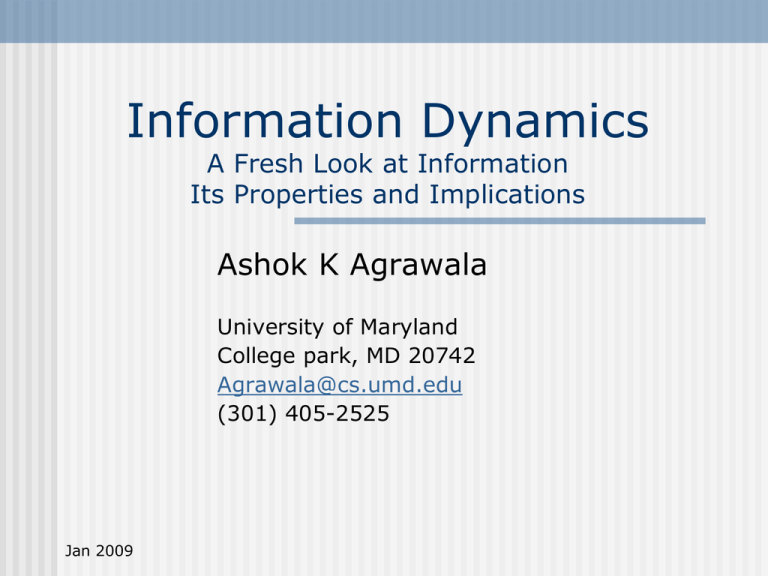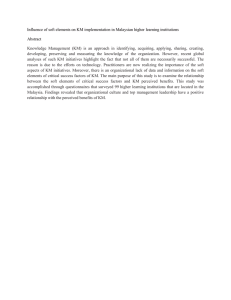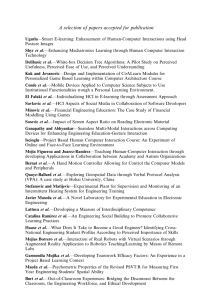Information Dynamics Ashok K Agrawala A Fresh Look at Information
advertisement

Information Dynamics A Fresh Look at Information Its Properties and Implications Ashok K Agrawala University of Maryland College park, MD 20742 Agrawala@cs.umd.edu (301) 405-2525 Jan 2009 Collaborators Christian Almazan Ron Larsen Udaya Shankar Doug Szajda Suman Banarjee Marat Fayzullin … Jan 2009 Jan 2009 What Information does this picture carry ? Has it changed recently? Jan 2009 Jan 2009 Jan 2009 Jan 2009 Jan 2009 Jan 2009 Jan 2009 What Information does this sequence carry ? What is the basic nature of Information? Only Sentient entities handle it! Jan 2009 What is Information ? Information is different from its representation !! 2 do 2 TWO II 010 Can have many representations Are they equivalent?? Jan 2009 Information Many forms Technical – Shannon Everyday use Distinction between information and its Representation Jan 2009 Information and Representation Information Information Sentient Entity Perceived Reality Perceived Reality Representation Representation Jan 2009 Information versus its Representation No one-to-one mapping Representation is meaningless without a relation to the appropriate contextual information Must understand the relationship of the representation to the appropriate information Representations are transmitted across boundaries via physical means (messaging, voices, etc.) All typical manipulations of information are through manipulations of its representation How is the mapping carried out? Jan 2009 Perceived Reality All a sentient entity knows… Facts Figures Relationships Models … …about The environment another entity or system Itself Jan 2009 Perceived Reality Any local node maintains its view of the universe and other entities in the form of Perceived Reality Perceived reality is based on Prior Model of the Universe and Other Entities Explicit information received and processed • Explicit information is processed to integrate it with the perceived reality • This integration is based on the model of the universe • Information may change the model All actions are initiated using the knowledge of the perceived reality All systems have been bootstrapped with information to start its “life” Jan 2009 Models Abstraction of an entity or a system. Contains properties and relationships believed to be true. One part of an entity’s perceived reality is the model of another entity. Constantly refined by information: New, Refuting, Removing, … Jan 2009 Perceived Reality When a message is received Its contents are converted into information based on the current perceived reality That information is assimilated into the current perceived reality A message (representation) can not be converted into information unless the perceived reality contains the means for reverse mapping • Language – Symbols - … Jan 2009 What is Information ? Information Entity Information has many interrelationships • attributes • properties Interrelationships are information also Such interrelationships exist whether they are enumerated/identified or not Jan 2009 Information and Representation From Information to Representation: Some facts will not be retained! Loss of relationships! Manipulation: Informational Representational Jan 2009 What is Information ? Information is handled by Sentient Entities Its representations can be handled by machines Machines only manipulate representations of information. 2+3=5 010 Adder 011 Jan 2009 101 Information and Representation Information Operation Information Sentient Perceived Reality Representation Jan 2009 Perceived Reality Operation Representation What Is Information ? It is a property /description/characteristics of something That something may be another piece of information An object – Physical, logical, virtual,conceptual – group An action A trigger A relationship Significance of Information is its interrelationships May be direct or indirect Exist whether enumerated or not May be static or dynamic Typically retain only small amount of information considered relevant in any system Jan 2009 Nature of Information Quantifiable Only in the context • Temperature in this room • • • • • Scale Accuracy Time it was recorded Who took it What instrument was used - precision Non-quantifiable Most of the information we deal with is of this type Jan 2009 Information Representation Representations are essential to store, move, or process information Capture only some aspects/views/projections of information – A good system designer carries other aspects in her head. Example: Data Structure Contains not only representation of some quantities but also of some relationships Jan 2009 Information Representation Use – Requires associating meaning to it Context Integer between 50 and 100 Represents temperature in this room in degrees F. If both sides understand the context Meaning can only be assigned in context Only need representation of integer number If not Common understanding may be English Include description along with the temperature value Jan 2009 Information Representation Algorithm Sequence of steps • Have common understanding of elemental steps • Depend on the way they are expressed • Machine instructions • Higher level language • Pseudocode • … Jan 2009 Multi-step Processing Jan 2009 Explicit and Implicit Information Explicit Conveyed explicitly through messages etc. Implicit Derived from explicit and the current knowledge of its relationships - perceived reality- models Requires processing • Spending Resources: Time and Energy Can be different for different agents !! Jan 2009 Meta-Information Ontology Levels of Meta Information? Jan 2009 What can we do with information Using Information requires ACTION Create/capture Store Move/Retrieve Use To derive implicit information – making it explicit To determine some other action to be taken (Choice) To activate a physical operation (output) Jan 2009 Storage of information In order to store any information which is explicit we need a representation for it In order to use it as information we need to retrieve it from storage A representation of information suitable for storage may not retain many interrelationships. On retrieving • some may be recalculated • some may be lost forever • In particular – information relating to time will be lost unless time stamping is done Storing/Retrieving of Information are actions Note that any and all actions generate lot more information than can be captured Jan 2009 Movement of information Only explicit (represented) information can be moved from one location to the other Information to be moved must be in a representation which is understood and can be interpreted by the sender and the receiver. The understanding can come from explicitly represented agreements ( which in turn require conventions - Protocols) It must be storable Requires an action Jan 2009 Information movement infrastructure Network Provides the ability to move info from location x to y Who initiates the move • When • Why How does y know that x has some information it needs? How does x know that y needs that information? Knowledge about where what information is? Search Engines !! • Have to know where the search engine is and how to access it. Jan 2009 Implications of Information Movement Moving information from location x to location y takes time txy At y we can only get information from x which is at least txy old Jan 2009 Information Uncertainty Principle-1 The perceived reality at any location CAN NOT be the same as the actual reality at any remote location of the global reality It is not sufficient to receive the information Due to the transmission and processing delays It must be interpreted and processed to integrate it with the current perceived reality Perceived reality at a location may be consistent with global/remote reality but can not be the same We can never have a complete model of another entity: models abstract knowledge Jan 2009 Information Uncertainty Principle - 2 Due to finite precision of measurement and representations we can never have complete and precise knowledge of any quantifiable information We deal with this uncertainty all the time !!! Jan 2009 Value of Information Implicit understanding of the value Is entity/agent specific Use in selecting – deciding among options for processing and taking action Value of information changes with time Different for each agent Depends on his perceived reality Can not assign a fixed ordinal scale to the value Jan 2009 Value of Information Value may be captured by uncertainty models Example – queue length at a router The knowledge of the queue length at time t may be precise The knowledge at a later time given the value at t will have a variance which will increase with time When we want to know the value of queue length from some other location, the information movement delay increases the variance Jan 2009 Information Fusion Given Multiple observations – How to integrate them into one “view” One view may contain multiple options / likely scenarios Jan 2009 Capture of Information Two mechanisms Observation – • Through direct or indirect observation/ monitoring/measurement Processing of info – Make implicit information explicit • • • • To enumerate interrelationships To make deductions To make inductions Using models Example: Mathematics A set of interrelationships with a description of when they apply A framework for deductions and inductions to add to the information base Analytical Results => defined interrelationships and descriptions of applicability Jan 2009 Action Physical Action Results in physical manipulation Non- Physical Thinking • Exploring interrelationships Processing within a computer Jan 2009 • All Actions take time and consume energy • Begins with an information trigger! • Usually done with respect to an event. Action Requires Processing Starts under the control of “Trigger” Needs Processor • Possibly other resources • For some time At a location Information as input Jan 2009 Outcome Additional Information • Explicit from Implicit Trigger(s) Storage Movement Physical results • Commands to actuators Three Levels Information Represented Information Physical Jan 2009 Types of Actions Make implicit information explicit Carry out interpretation/storage/movement of information Carry out a physical action by issuing a command to a physical processor Transform some information into some trigger which is used to control some later action Jan 2009 Trigger Required for carrying out an action at a particular time/under some conditions Defines What action, where, using what resources, at what time or under what conditions (priority, precedence etc.) Based on information/location/time/value Requires processing to convert information into a Trigger When relationships are fixed – hardwired design – Design time Trigger When relationships are dynamic trigger has to reflect it Jan 2009 Large Complex System A collection of N entities capable of carrying out certain operations Has a mission Physical resources which can carry out the actions At various locations Mechanism for moving information (communication) Design Carried out at Information Level Jan 2009 Coordination: A Distributed System Information-centric view Many interacting autonomous agents Who needs what information at what time • Why • How will he use it Who has that information at what time How to get the right information at the right place at the right time Most algorithms – mechanisms for such movement of information with respect to elemental processing capabilities assumed Jan 2009 Role of Time Do we need a global/universal clock? What type of time is appropriate for Information Dynamics? Absolute Time with a Counter (though it has a value relative to a starting point) Relative Time through Causality Jan 2009 Consistency How can coordination take place without consistency of models each entity has from one another? Models between communicating entities must be consistent and accurate enough Who has the responsibility to fix broken models? Do models follow a set of rules? Logically, relationally, or operationally. Jan 2009 Awareness In order for entity A to be aware of entity B, entity A must have a model of entity B. Entity B need not have a model of entity A. Being aware does not mean having complete knowledge of another. Jan 2009 Levels of Abstraction Any massively complex system has to be viewed at an appropriate level of complexity Information with right degree of detail Only relationships of interest and their connections of interest are retained Jan 2009 Planning Requires knowledge about future Using Models Estimates • Accuracy • Confidence Knowledge of Dynamics Expected changes over time Jan 2009 Example – Mutual Exclusion Problem N Agents - Cooperative Any agent can enter its CS if nobody else is in its CS Entry CS Exit Check if anybody is in its CS If not – enter If yes – wait and try again Each action takes time State of agents can change in that time Jan 2009 Non – CS LOOP Mutual Exclusion Problem How to know the state of all other agents Shared memory model Distributed – • through messages Shared Memory Model Set up a mechanism for sharing of state information • Semaphore Delay • Atomic action Define checking mechanism Jan 2009 Distributed Messages Algorithms vary in terms of the implications of messages and their meaning Simplest – Ask everybody for permission and enter when received from everybody How to process a permission request? Example - Security A B Key Key Key – part of “perceived reality” How does B know which key to use? Public Key encryption Jan 2009 Example – Link State Routing Each node measures delays Periodically send the measured delay to every other node Determine route as the minimum delay path from source to destination Jan 2009 Need delay when packet gets there not what it was Estimate of future delay rapidly moves towards the steady state values IF Steady State values are known Reduce communication Improve routing Demonstrated through implementation/simulation Information-centric Design Having right information at the right place at the right time Explicitly take into account the time dependent aspect of information Explicitly take into account the value of information Explicitly take into account implicit information Organize/design system based on the dynamics of information requirements Jan 2009 Rover Technology Context-aware computing platform Location Time Self-describing Information Representations Services/actions depend on context Jan 2009 Rover Technology Comm Server Rover Clients PPMP DB Server PPRP Rover Server Location Server Web Server PPMP – PinPoint Mobile Point PPRP – PinPoint Reference Point Jan 2009 Rover Technology Designed to address issues in Enterprise Applications Command and Control Applications Pervasive Computing Sensor Networks … Jan 2009 Rover Network Diagram MINDLab Network 8400 Baltimore Avenue Watcher 1 UMD Wireless Network AV Williams Building, 3rd and 4th Floors Unit 1 Unit 2 Unit 1 Listens for position activity, performs tagging operations, and utilizes other services. Units inform their position, performs tagging operations, and utilizes other services. Watcher 1 Unit 2 UMD/CS Unsupported Public Network AV Williams Building, Room 4160 Mitigates Rover Services Between Rover Clients Including: Server User Position Notification Map Tagging Text Chat Internet Services The Internet UMD/CS Unsupported Private Network AV Williams Building, Room 4160 Watcher 2 Watcher 2 Jan 2009 Listens for position activity, performs tagging operations, and utilizes other services. Rover Server accesses internet services as a proxy for Rover Clients, with Services including (with support for caching): Yahoo! News and Web Searches via REST Yahoo! Weather RSS Feeds Uses of Information Dynamics Framework for Approaching system designs System Analysis • Given a design determine • All Information Dynamics – Explicit and Implicit • Decision Structure • Actions System Synthesis • Outcome required • Processing/Action needed • Information needed Jan 2009 Questions??? Jan 2009


